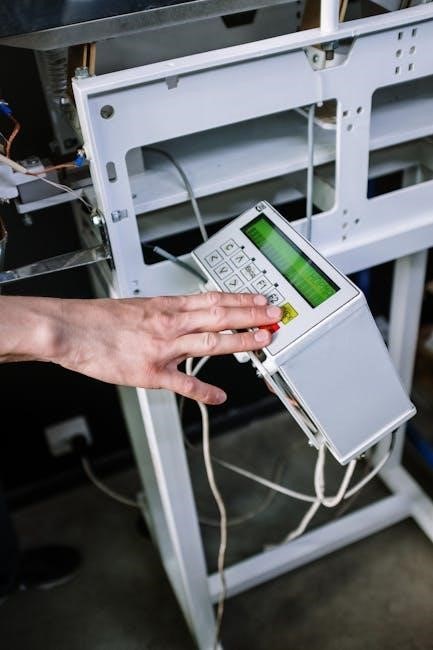1․1 Overview of the Honeywell 6150 Keypad
The Honeywell 6150 Keypad is an addressable remote keypad designed for use with Ademco control panels, offering a user-friendly interface for home and business security systems․
It features a 2-digit numeric display, English-language prompts, and function keys for arming, disarming, and panic alarms, making it intuitive for users of all skill levels․
With LED indicators for system status and support for wireless connectivity, the 6150 keypad is a reliable and versatile solution for managing security operations effectively․
The Honeywell 6150 Keypad is a sleek, user-friendly security interface designed for compatibility with Ademco control panels․ It features a 2-digit numeric display, English-language prompts, and function keys for streamlined operation․ The keypad includes panic alarm buttons for emergencies and LED indicators for system status updates․ With wireless connectivity options and addressable functionality, it offers flexibility for both residential and commercial security systems․ Its intuitive design ensures easy arming, disarming, and monitoring of zones, making it a reliable choice for users seeking efficient security management․
1․2 Importance of the User Manual
The Honeywell 6150 Keypad User Manual is essential for understanding and utilizing the device’s features effectively․ It provides detailed instructions for installation, operation, and troubleshooting, ensuring users can navigate the system confidently․ The manual covers key functions like arming, disarming, and panic alarms, as well as advanced settings for customization․ By following the guide, users can avoid common errors and ensure proper system setup and maintenance․ Additionally, it serves as a reference for resolving issues, making it a vital resource for both homeowners and professional installers․ The manual ensures optimal performance and security, catering to all user needs․
1․3 Target Audience
The Honeywell 6150 Keypad User Manual is designed for homeowners, security professionals, and business owners seeking to install, operate, and maintain their security systems effectively․ It caters to both technical and non-technical users, providing clear instructions for arming, disarming, and configuring the keypad․ The manual is particularly useful for individuals new to security systems, as well as experienced users looking to optimize their setup․ By addressing a broad range of user needs, the manual ensures that everyone can utilize the Honeywell 6150 Keypad with confidence and efficiency, enhancing overall security and system performance․

Features of the Honeywell 6150 Keypad
The Honeywell 6150 Keypad features a 2-digit numeric display, English-language prompts, and function keys for arming, disarming, and panic alarms․ It includes LED indicators for system status and supports wireless connectivity, ensuring enhanced security and user convenience․ The keypad is designed for intuitive operation, making it easy to navigate and control various security functions effectively․
2․1 Display and Interface
The Honeywell 6150 Keypad features a clear 2-digit numeric display that provides zone identification and system status updates․ The interface includes English-language prompts, ensuring easy navigation for users․ The keypad is designed with a user-friendly layout, offering function keys for arming, disarming, and panic alarms․ The display is backlit for visibility in low-light conditions, and the intuitive design allows for quick access to essential security functions․ LED indicators provide visual feedback on system status, such as ready, armed, or alarm conditions, making it easy to monitor and control the security system effectively․
2․2 Language Prompts
The Honeywell 6150 Keypad incorporates pre-designated English-language prompts, enhancing user experience by providing clear instructions and system status updates․ These prompts guide users through arming, disarming, and panic alarm functions, ensuring intuitive operation․ The language prompts are displayed on the keypad’s screen, offering real-time feedback and simplifying system interactions․ This feature is particularly beneficial for users who prefer straightforward communication, making the keypad accessible to a wide range of users, including those less familiar with technical jargon․ The clear and concise language ensures that users can quickly understand and respond to system notifications, improving overall security management efficiency․
2․3 Function Keys
The Honeywell 6150 Keypad features a set of function keys designed to simplify security system operations․ These keys provide quick access to essential commands, such as arming (AWAY, STAY, MAX), disarming, and zone bypass․ The AWAY key arms all zones, while STAY arms perimeter zones only, and MAX enables instant arming for heightened security․ Additional keys include BYPASS for temporarily disabling specific zones and TEST for system verification․ The function keys are clearly labeled and intuitive, allowing users to perform tasks efficiently․ LED indicators provide visual feedback, confirming the success of each operation․ This streamlined design ensures seamless interaction with the security system․
2․4 Panic Alarm Keys
The Honeywell 6150 Keypad includes dedicated panic alarm keys for emergency situations․ These keys allow immediate activation of police, fire, or medical alarms․ Users can press a single panic button or a combination of buttons to trigger the appropriate response․ For example, pressing the * and 1 keys simultaneously signals a medical emergency, while # and 2 activates a fire alarm․ The keypad provides audible and visual confirmation when a panic alarm is triggered, ensuring the user knows the system has responded․ This feature offers quick access to help in critical situations, enhancing overall security and peace of mind․
2․5 LED Indicators
The Honeywell 6150 Keypad features LED indicators that provide visual feedback on system status․ A green LED indicates the system is ready for arming, while a red LED signals that the system is armed․ An amber LED alerts users to system issues or faults․ These indicators help users quickly assess the security status without relying solely on the display․ The LEDs also flash during alarm conditions or keypad activity, ensuring clear communication of system states․ This visual feedback enhances user experience and ensures prompt responses to security events or system notifications․

Installation and Setup
The Honeywell 6150 Keypad installation involves surface mounting or using an electrical box․ Ensure proper wiring connections and maintain a 10-foot distance from the control panel․
3․1 Mounting Options
The Honeywell 6150 Keypad offers flexible mounting options to suit various installation needs․ It can be surface-mounted directly to drywall or installed using a single- or double-gang electrical box․
For optimal placement, ensure the keypad is at least 10 feet away from the control panel to avoid interference․ It should also be positioned to avoid direct sunlight or moisture exposure․
Mounting hardware is typically included, and the keypad’s compact design ensures it blends seamlessly into any room’s décor while maintaining easy access for users․
3․2 Wiring Requirements
The Honeywell 6150 Keypad requires a 4-wire connection for power and communication with the control panel․ Proper wiring is essential to ensure reliable operation․
Use 18-22 AWG wires, ensuring they are securely connected to the keypad’s terminal strip․ The power supply should meet the system’s voltage requirements, typically 12VDC․
Follow the manufacturer’s wiring diagram to avoid short circuits or damage․ Installing the keypad 10 feet away from the control panel minimizes interference and ensures optimal performance․
3․3 Initial Setup Steps
Mount the keypad securely, ensuring it is level and accessible․ Connect the wires according to the wiring diagram, matching the keypad terminals to the control panel outputs․
Power on the system and allow the keypad to initialize․ Set the keypad address using the function keys, following the control panel’s addressing scheme․
If using wireless keys, enroll them by pressing any button on the wireless key until the keypad beeps three times; Test the system by arming and disarming to ensure proper functionality․
Verify that the ready light is on, indicating the system is operational and ready for normal use․ Refer to the user manual for detailed instructions and troubleshooting tips․

Operating the Honeywell 6150 Keypad
The Honeywell 6150 Keypad provides straightforward operation with a 2-digit display and clear English prompts․ LED indicators and function keys make managing security tasks simple and efficient for all users․
4․1 Arming the System
To arm the system, ensure all protected doors and windows are closed․ The keypad’s green ready light must be on, indicating the system is prepared for arming․ Press the appropriate function key: 2 for AWAY mode, which activates all security features, or 3 for STAY mode, which bypasses motion detectors․ For instant arming without delays, press the INSTANT key․ The system will confirm arming with a beep and update the display․ LED indicators will show the current arming status․ Always verify the display and LEDs to ensure the system is armed correctly for your security needs․
4․2 Disarming the System
To disarm the system, start by entering your valid user code using the keypad․ The system will confirm disarmament with a series of beeps and update the display to reflect the disarmed status․ Ensure the ready light turns off and the armed indicators (AWAY or STAY) disappear․ If the system was armed in AWAY mode, disarming will deactivate all security features․ For STAY mode, motion detectors will be reactivated; Always verify the display and LED indicators to confirm the system is fully disarmed before accessing protected areas․ Proper disarmament ensures your security system operates correctly and avoids unnecessary alarms․
4․3 Using Panic Buttons
The Honeywell 6150 Keypad features dedicated panic buttons for emergency situations․ Press and hold the POLICE, FIRE, or MEDICAL button to send an immediate alert to your monitoring station․ Ensure the system is disarmed before testing․ In a real emergency, press the button firmly until the keypad confirms the signal․ Stay on the line if prompted for further instructions․ These buttons are designed for quick access during critical moments, providing an essential layer of security and peace of mind for users․ Always use the panic feature responsibly to avoid unnecessary emergency responses․
4․4 Understanding System Status
The Honeywell 6150 Keypad provides clear system status updates through its display and LED indicators․ The keypad shows messages like “READY,” “ARMED AWAY,” or “ARMED STAY” to indicate the current security mode․ The green LED lights when the system is ready for arming, while red indicates an armed state․ Additionally, the display alerts users to open zones, bypassed sensors, or low battery conditions․ Understanding these visual cues helps users maintain awareness of their security system’s status and take appropriate actions promptly, ensuring optimal protection and functionality․ This feature is essential for effective system monitoring and response․

Customization and Configuration
The Honeywell 6150 Keypad allows users to customize settings like user codes, zone configurations, and display preferences to tailor the system to their specific needs and preferences․
Advanced features include setting up notifications and adjusting access levels, ensuring a personalized and secure experience for all users of the security system․
5․1 User Codes and Access Levels
The Honeywell 6150 Keypad supports multiple user codes, allowing personalized access for different users․ Each code can be assigned specific access levels, granting varying degrees of control over the system․
Users can program up to eight unique codes, with the master code retaining superior access rights․ Access levels determine permissions, such as arming/disarming, bypassing zones, or viewing system status․
Codes must be 1-6 digits long and can be modified through the control panel․ Ensuring secure code management is crucial for system security and user accountability․
Regular updates to user codes and access levels help maintain system integrity and adapt to changing user needs or organizational structures․
5․2 Zone Configuration
The Honeywell 6150 Keypad enables precise zone configuration, allowing users to define and customize security zones within their premises․ Each zone can be assigned to specific areas or devices, such as doors, windows, or motion detectors, ensuring tailored monitoring and alerts․ Zone types can be set to “entry/exit,” “perimeter,” or “interior,” depending on the location and security needs․ Users can also bypass zones temporarily without disarming the entire system․ The keypad’s display provides clear zone identification, while the control panel offers advanced options for fine-tuning zone settings․ Proper zone configuration is essential for accurate system responses and reliable security monitoring․
5․3 Customizing Display Settings
The Honeywell 6150 Keypad offers customizable display settings to enhance user experience․ Users can adjust brightness and contrast for optimal visibility in various lighting conditions․ The keypad also supports personalized zone labels, allowing users to assign meaningful names or numbers to security zones․ Language prompts can be configured to display system messages in English or other supported languages․ Additionally, the display can be set to show real-time status updates, such as “READY,” “ARMED,” or “ALARM,” ensuring clarity in system operation․ These customization options enable users to tailor the keypad’s display to their preferences and operational needs, improving overall usability and convenience․

5․4 Setting Up Notifications
The Honeywell 6150 Keypad allows users to set up customizable notifications for system events․ Notifications can be configured for arming, disarming, alarm triggers, and low battery warnings․ Users can enable alerts for specific zones or system-wide events․ To configure notifications, access the menu by entering the user code, navigate to the notification settings, and select the desired alerts․ This feature ensures users stay informed about system activity․ Customizable notifications enhance security monitoring and provide peace of mind by keeping users updated on their system’s status and any potential issues․

Advanced Features
The Honeywell 6150 Keypad offers advanced features like wireless connectivity, integration with smart devices, and remote monitoring capabilities․ These features enhance security and user convenience significantly․
Additionally, it supports gesture control and hands-free operation, providing a modern and seamless experience for users․ These advanced functionalities make the keypad highly versatile and efficient․
6․1 Wireless Connectivity
The Honeywell 6150 Keypad supports wireless connectivity, enhancing convenience and reducing the need for extensive wiring․ The 6150RF model acts as a transceiver, enabling seamless communication with the control panel and other wireless devices․ This feature allows for remote arming, disarming, and monitoring, ensuring a robust security solution․ The keypad can integrate with wireless sensors and key fobs, providing real-time notifications and status updates․ Its wireless range is reliable, ensuring consistent performance even in larger properties․ This feature is particularly beneficial for users seeking modern, flexible security solutions without compromising on functionality or ease of use․
6․2 Integration with Other Devices
The Honeywell 6150 Keypad seamlessly integrates with various security and smart home systems, enhancing its functionality․ It is compatible with Ademco control panels and supports Total Connect 2․0 for remote monitoring․ Additionally, it works with Alarm․com, enabling users to receive notifications and control their systems via smartphones․ The keypad also integrates with Hikvision devices, offering enhanced video surveillance capabilities․ Its wireless connectivity allows it to pair with sensors, cameras, and key fobs, creating a comprehensive security ecosystem․ This versatility ensures the Honeywell 6150 Keypad can adapt to diverse security needs, making it a central hub for modern home and business protection systems․
6․3 Remote Monitoring and Control
The Honeywell 6150 Keypad supports remote monitoring and control through platforms like Total Connect 2․0 and Alarm․com․ Users can access their security systems via smartphones or tablets, allowing them to arm or disarm the system, check real-time status, and receive notifications for events like alarms or system breaches․ This feature ensures convenience and peace of mind, enabling users to manage their security settings even when they’re not physically present․ Remote control capabilities make it easier to handle security operations efficiently, providing an added layer of flexibility for home and business owners alike․
6․4 Gesture and Hands-Free Operation
The Honeywell 6150 Keypad offers advanced gesture and hands-free operation features, enhancing user convenience and accessibility․ Users can perform specific motions near the keypad to trigger functions like arming or disarming the system․ For instance, a simple hand wave can activate the system, while other gestures can be programmed for custom actions․ Additionally, voice commands can be integrated through compatible smart systems, allowing users to control the keypad without physical interaction․ These features provide a modern and intuitive way to manage security settings, making the Honeywell 6150 Keypad a cutting-edge solution for home and business security needs․

Maintenance and Upkeep
Regularly clean the keypad with a soft cloth to prevent dust buildup․ Update firmware periodically for optimal performance․ Replace batteries as needed to ensure reliable operation․
7․1 Cleaning the Keypad
Regular cleaning ensures optimal functionality and longevity of the Honeywell 6150 Keypad․ Use a soft, dry cloth to gently wipe the keypad’s surface, removing dirt and dust․
Avoid harsh chemicals or abrasive cleaners, as they may damage the display or keys․ For tougher stains, lightly dampen the cloth with water, but ensure no moisture seeps into the keypad․
Never submerge the keypad in liquid or expose it to excessive humidity․ Allow the keypad to air dry completely before use if it comes into contact with moisture;
By maintaining a clean and dry keypad, you ensure reliable performance and extend its operational life․
7․2 Updating Firmware
Updating the firmware of your Honeywell 6150 Keypad ensures access to the latest features, security patches, and performance enhancements․ Always download firmware updates from Honeywell’s official website to avoid unauthorized versions․
Before initiating the update, ensure the keypad is connected to the control panel and has a stable power supply․ Follow the step-by-step instructions provided in the user manual or on Honeywell’s support portal․
Do not interrupt the update process, as this could cause system instability․ Once the update is complete, test the keypad to ensure all functions operate correctly․ Regular firmware updates are crucial for maintaining optimal performance and security․
7․3 Battery Replacement
Regular battery replacement is essential for maintaining the Honeywell 6150 Keypad’s functionality, especially in wireless models․ Ensure the keypad is powered off before replacing batteries to avoid data loss or system instability․
Use high-quality, alkaline batteries compatible with the keypad’s specifications․ Replace the batteries by removing the compartment located on the back or bottom of the keypad․ Follow the polarity markings to insert the new batteries correctly․
Dispose of old batteries responsibly, adhering to local regulations․ After replacement, test the keypad to ensure proper operation․ Regular battery checks prevent unexpected system downtime and maintain security reliability․

Troubleshooting Common Issues
Identify symptoms like keypad unresponsiveness or display malfunctions․ Check wiring connections, power supply, and battery levels․ Perform a system reset or consult error codes for solutions․
8․1 Keypad Not Responding
If the Honeywell 6150 keypad is unresponsive, first ensure it has power․ Check wiring connections and battery levels if applicable․ Verify no buttons are stuck or damaged․
Reset the keypad by disconnecting and reconnecting the power source․ If issues persist, test the keypad on a different control panel to isolate the problem․
Consult the error codes or manual for specific troubleshooting steps․ Contact a professional if the keypad remains non-functional after these checks․
8․2 Display Issues
If the Honeywell 6150 keypad display is not functioning correctly, start by turning the keypad off and on again to reset it․ Clean the display with a soft cloth to remove dirt or smudges that may be obstructing visibility․
Check the wiring connections to ensure they are secure and not damaged․ If the issue persists, verify that the display settings are configured properly in the system menu․
If the problem remains unresolved, it may indicate a hardware fault․ Contact a certified technician for further diagnosis and repair to restore proper display functionality․
8․3 Connectivity Problems
If experiencing connectivity issues with the Honeywell 6150 keypad, ensure it is within range of the control panel, typically up to 10 feet․ Check for physical obstructions like metal walls or interference from other electronic devices․
Verify that the keypad is properly enrolled with the control panel․ If using wireless connectivity, ensure the transceiver is functioning correctly and signals are strong․ Restart the keypad and control panel to reset the connection․
If issues persist, test the keypad in different locations to identify signal strength variations․ Consult the user manual or contact a certified technician for advanced troubleshooting and resolution․
8․4 Error Codes and Solutions
The Honeywell 6150 keypad may display error codes to indicate specific issues․ Common codes include “FC” for communication failures and “OE” for system overloads; To resolve these, ensure all connections are secure and restart the system․
For “FC” errors, check the keypad’s signal strength and proximity to the control panel․ If “OE” appears, reduce the number of active zones or update the system firmware․ Refer to the manual for a full list of codes and detailed solutions․
Consult a certified technician if issues persist after troubleshooting․ Regularly updating firmware and ensuring proper installation can prevent many error code occurrences․

Security and Safety Precautions
Always test the system regularly to ensure proper function․ Keep doors and windows closed when arming․ The green ready light confirms the system is secure․
Avoid false alarms by ensuring all users understand the system operation․ Follow all safety guidelines to maintain optimal security and reliability of the Honeywell 6150 keypad․
9․1 Ensuring System Security
To ensure system security, always test the keypad regularly and verify that all protected doors and windows are closed before arming․ The green ready light confirms the system is secure․
Use strong, unique user codes and update them periodically․ Avoid sharing codes with unauthorized individuals․ Regularly inspect wires and connections to prevent tampering or damage․
Keep the keypad firmware updated to protect against vulnerabilities․ Test panic buttons and emergency procedures to ensure they function correctly during critical situations․ Monitor system activity and address any unusual behavior promptly․
By following these steps, you can maintain a secure and reliable home or business security system using the Honeywell 6150 keypad․ Always refer to the user manual for detailed instructions and guidelines․
9;2 Protecting User Data
Protecting user data is crucial for maintaining security and privacy․ Ensure all user codes are strong and unique, avoiding common or easily guessable sequences․ Regularly update codes and limit access to authorized individuals only․
Store user manuals and system documentation securely to prevent unauthorized access․ Use encryption for any data transmitted or stored by the keypad․ Avoid sharing sensitive information publicly or with third parties․
Monitor system activity and address any unauthorized access promptly․ Regularly back up user data and ensure it is stored securely․ By taking these measures, you can safeguard user information and maintain the integrity of your security system․
9․3 Emergency Procedures
In case of an emergency, press the panic alarm keys to trigger an immediate alert․ Ensure all users know the location of these keys and understand their function․ The keypad’s panic buttons activate police or medical alerts, sending distress signals to monitoring centers․
After triggering an alarm, evacuate the premises and assemble at a safe location․ Do not re-enter the building until authorities confirm it is safe․ Keep emergency contact numbers readily available near the keypad for quick access․
Regularly test the panic alarm system to ensure it functions correctly․ Train all users on emergency protocols to avoid delays during critical situations․ Familiarity with these procedures enhances safety and ensures a swift response in emergencies․
The Honeywell 6150 Keypad offers a comprehensive security solution with advanced features and user-friendly controls, ensuring enhanced protection and convenience for users․
10․1 Summary of Key Features
The Honeywell 6150 Keypad is a versatile security solution offering a range of essential features for efficient system control․ It includes a 2-digit numeric display, English-language prompts, and function keys for arming, disarming, and panic alarms․ The keypad also features LED indicators for system status and supports wireless connectivity for enhanced convenience․ Designed for both home and business use, it provides a user-friendly interface with advanced security options․ Its reliability and ease of use make it a preferred choice for managing security systems effectively․
10․2 Final Tips for Optimal Use
For optimal use of the Honeywell 6150 Keypad, ensure regular cleaning of the keypad to maintain functionality․ Always keep the firmware updated to benefit from the latest features and security enhancements․ Check battery levels periodically to avoid unexpected system downtime․ Familiarize yourself with all function keys and panic buttons to respond quickly in emergencies․ Test the system regularly to ensure proper operation and address any issues promptly․ Refer to the user manual for troubleshooting common problems and to explore advanced settings․ By following these tips, you can maximize the security and convenience provided by the Honeywell 6150 Keypad․
